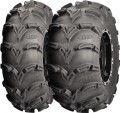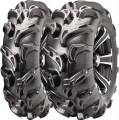Nominal tyre width; measured along sidewalls in uninflated/unloaded condition. This is one of the parameters on which the possibility of installation on a particular ATV (along with the rim diameter) depends. However, the requirements for the width are somewhat softer than for the diameter: on stock ("native") disks, tyres with an excess of the recommended width by 1", on some non-stock disks — up to 2" are allowed. These nuances are described in more detail in special sources. However, for maximum warranty, it is better not to deviate from the recommendations specified in the documents for the ATV or wheels, and use tyres with the width that is directly recommended by the manufacturer.
The tyre width options that are relevant for modern ATVs are
7",
8",
9",
10",
11",
12".
The axle for which the tyre was originally designed.
The division by this parameter is due to the fact that both the front and rear axles have their own characteristics. So, the rear wheels are responsible for traction even in models that do not have all-wheel drive, so the
tyres for the rear wheels (Rear) must tolerate twisting along the rotation axis well. The front axle is responsible for cornering, and
tyres for the front wheels (Front) must be resistant to twisting from side to side (around the axis perpendicular to the axis of rotation). In addition, the front wheels are often made narrower than the rear ones, which implies a corresponding difference in the size of the rubber.
Note that there are also
universal models on the market, suitable for both front and rear wheels. This format eliminates the hassle of searching and installing — you can put tyres from the same line on both axles (taking into account the difference in the width of the front and rear wheels) and not bother with the selection of mutually compatible tyres of different models. On the other hand, a universal design is either less efficient than a specialized one, or more expensive; so it is relatively rare.

